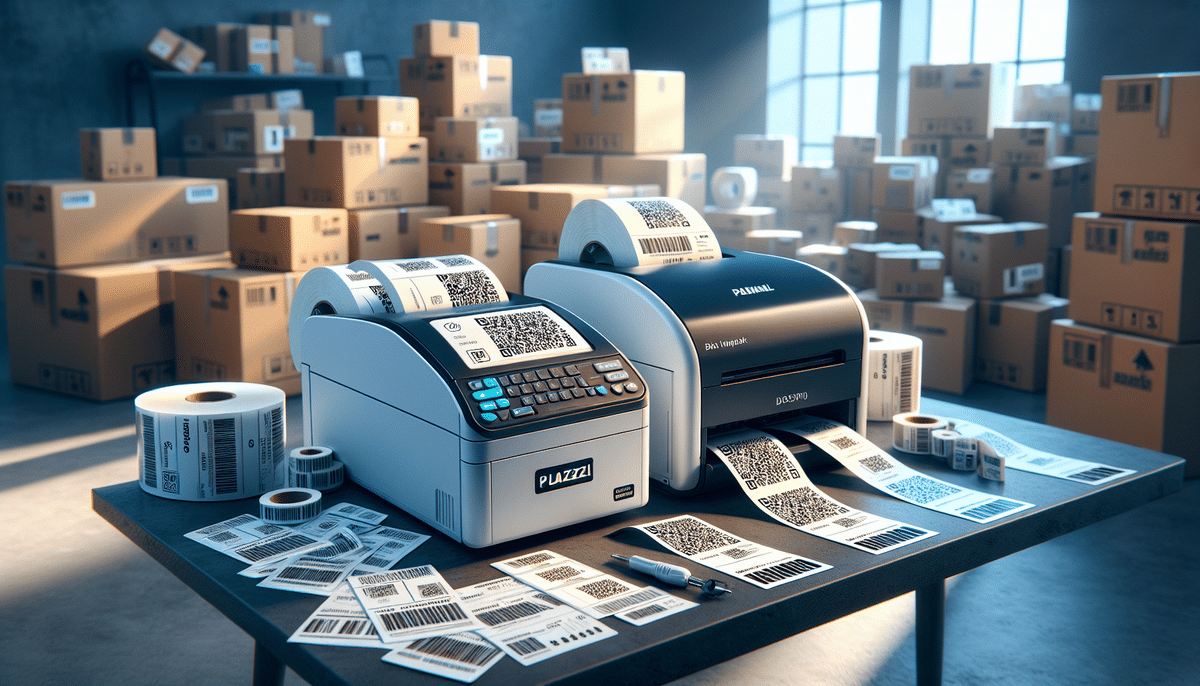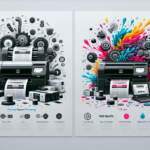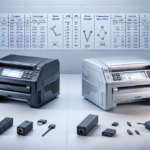Introduction to Label Printers
Label printers are essential tools for businesses, especially those involved in inventory management and shipping. These specialized printers generate labels, tags, and barcodes vital for various operational aspects such as tracking products, managing stock levels, and ensuring accurate deliveries. By printing barcodes, QR codes, product details, and other critical information, label printers enable businesses to maintain organized and efficient workflows.
Label printers come in various types and sizes to cater to different business needs:
- Desktop Label Printers: Perfect for small businesses or home offices, offering compact sizes and adequate functionality for low to moderate printing volumes.
- Industrial Label Printers: Designed for high-volume printing environments, these printers handle larger label sizes and provide robust performance for demanding tasks.
Modern label printers boast advanced features that enhance efficiency and productivity, including:
- Wireless Connectivity: Allows printing from multiple devices without the need for physical connections.
- Touchscreens: Offer intuitive interfaces for easier navigation and operation.
- Automatic Label Cutters: Streamline the label production process by automating cutting tasks.
For a comprehensive overview of label printer types and their applications, refer to the Avery Label Printers Guide.
Key Features of TSC TTP-244CE
The TSC TTP-244CE is a reliable thermal transfer printer favored by businesses requiring high-quality label printing. Key features include:
- Print Speed: Delivers up to 4 inches per second, ensuring timely label production.
- Label Width: Accommodates labels up to 4.25 inches wide, suitable for various label sizes.
- Compatibility: Supports multiple operating systems and software programs, facilitating seamless integration into existing workflows.
- Durability: Built with a sturdy construction to withstand frequent use in busy environments.
Connectivity options are extensive, including:
- Ethernet and USB: Allow multiple users to access the printer from different devices.
- Wireless Connectivity: Enables printing from mobile devices and laptops without cables.
The printer's user-friendly design features a clear LCD display and intuitive buttons, complemented by functionalities like automatic label peeling and a label gap sensor for accurate label positioning.
For more details, visit the official TSC TTP-244CE Product Page.
Key Features of Zebra ZP450
The Zebra ZP450 is a highly regarded direct thermal printer, popular across various business sizes for its efficiency and compact design. Notable features include:
- Print Speed: Achieves up to 5 inches per second, facilitating rapid label printing.
- Label Width: Handles labels up to 4.09 inches wide, suitable for standard labeling needs.
- Compact Design: Easily fits into tight workspaces without compromising functionality.
- Compatibility: Integrates seamlessly with a wide range of software programs and operating systems.
Connectivity is versatile, offering:
- USB, Ethernet, and Serial Ports: Enable integration with diverse devices and systems, enhancing the printer's adaptability.
Constructed for durability, the Zebra ZP450 withstands the demands of daily use, ensuring reliable performance for businesses with consistent labeling requirements.
Learn more on the official Zebra ZP450 Product Page.
Performance Comparison: TSC TTP-244CE vs Zebra ZP450
Both the TSC TTP-244CE and Zebra ZP450 are esteemed for their reliability and efficiency in label printing. Here's how they compare:
- Print Speed: The Zebra ZP450 offers a slightly faster print speed of 5 inches per second compared to the TSC TTP-244CE's 4 inches per second.
- Label Width: TSC TTP-244CE accommodates wider labels (4.25 inches) than the Zebra ZP450 (4.09 inches), which may be crucial for businesses requiring larger labels.
- Print Quality: Both printers deliver high-quality, sharp labels, suitable for various applications.
Connectivity:
- The TSC TTP-244CE offers USB, Ethernet, and serial connectivity, providing flexibility in connecting to different devices and older equipment.
- The Zebra ZP450 primarily offers USB and Ethernet connectivity, which may limit integration options compared to the TSC model.
For businesses prioritizing versatile connectivity and slightly wider label support, the TSC TTP-244CE may be the preferable choice. However, for those valuing higher print speeds, the Zebra ZP450 might better serve their needs.
Reference industry standards and performance benchmarks from Epson's Label Printer Performance Report for detailed insights.
Print Quality Comparison: TSC TTP-244CE vs Zebra ZP450
When evaluating print quality, both printers excel in producing clear and legible labels. However, there are subtle differences:
- TSC TTP-244CE: Utilizes thermal transfer ribbons, resulting in sharper and more durable prints that are less prone to fading over time.
- Zebra ZP450: Employs direct thermal printing, which is efficient but may result in prints that are more susceptible to fading, especially when exposed to heat and sunlight.
Printing Speed:
- The TSC TTP-244CE operates at up to 4 inches per second, while the Zebra ZP450 reaches up to 5 inches per second. For large-scale printing tasks, the Zebra offers a speed advantage.
Memory Capacity:
- The TSC TTP-244CE boasts a larger memory capacity, enabling the storage of more label formats and graphics, which enhances its versatility for complex labeling needs.
Both printers meet the standards required for inventory management, shipping, and product identification. For an in-depth analysis of thermal versus direct thermal printing technologies, consult the Barcode FAQ Thermal Printing Guide.
Connectivity and Compatibility Comparison: TSC TTP-244CE vs Zebra ZP450
Connectivity is a critical factor in integrating label printers into existing business systems. Here's how the two models compare:
- TSC TTP-244CE:
- USB 2.0
- Ethernet
- Serial Connectivity
- Zebra ZP450:
- USB
- Ethernet
- Serial Ports
The TSC TTP-244CE offers more extensive connectivity options, including support for older serial connections, which can be advantageous for businesses utilizing legacy systems. In contrast, the Zebra ZP450 focuses on modern connectivity with USB and Ethernet, catering to contemporary networking environments.
Compatibility extends to various software programs and operating systems, ensuring both printers can seamlessly integrate into diverse business workflows. For comprehensive compatibility lists, refer to the TSC Printers Compatibility Resources and Zebra Support Downloads.
Ease of Use Comparison: TSC TTP-244CE vs Zebra ZP450
User experience is paramount in selecting a label printer. Both the TSC TTP-244CE and Zebra ZP450 are designed for ease of use, featuring intuitive interfaces and straightforward software. However, there are distinctions:
- Zebra ZP450: Known for its simpler design and fewer connectivity options, it often requires less initial setup, making it ideal for businesses seeking immediate deployment.
- TSC TTP-244CE: While offering more connectivity choices and features like automatic label peeling, it may necessitate additional setup and calibration, which can be a consideration for businesses prioritizing quick installation.
Both printers minimize the learning curve, but the Zebra ZP450 may offer a slight advantage in terms of immediate usability. For user manuals and setup guides, visit the respective TSC TTP-244CE Manual and Zebra ZP450 Manual.
Price Comparison: TSC TTP-244CE vs Zebra ZP450
Pricing is a crucial factor in decision-making for businesses. Generally:
- TSC TTP-244CE: Priced around $300, reflecting its advanced features and durability.
- Zebra ZP450: More affordable, with prices starting at approximately $200.
While the TSC TTP-244CE has a higher initial cost, its broader label width capability and robust construction may offer better long-term value for businesses with extensive labeling needs. In contrast, the Zebra ZP450 provides cost-effective solutions for businesses with standard requirements.
For the latest pricing and available discounts, visit the official TSC Printers Pricing Page and Zebra ZP450 Pricing Information.
Customer Reviews and Feedback on TSC TTP-244CE
Feedback from users of the TSC TTP-244CE highlights its durability and reliability:
- Pros:
- Produces high-quality, easy-to-read labels.
- Sturdy construction suitable for heavy use.
- Versatile connectivity options.
- Cons:
- Some users experience connectivity and compatibility issues, often resolvable with proper setup.
- Initial setup may require more time compared to simpler models.
Overall, the TSC TTP-244CE is well-regarded for its performance and longevity, making it a trusted choice among businesses.
Read comprehensive reviews on platforms like Capterra and G2.
Customer Reviews and Feedback on Zebra ZP450
Users of the Zebra ZP450 appreciate its ease of use and affordability:
- Pros:
- Simple setup process requiring minimal training.
- Cost-effective solution for standard labeling needs.
- Compact design saves workspace.
- Cons:
- Some users report issues with print quality, such as fading or smudging over time.
- Durability concerns under high-volume use.
Despite some isolated issues, the Zebra ZP450 remains a popular choice for businesses seeking reliable and budget-friendly label printing solutions.
Explore user testimonials on platforms like Capterra and G2.
Which Label Printer is Suitable for Your Business?
Choosing between the TSC TTP-244CE and Zebra ZP450 depends on your business's specific needs:
- Choose TSC TTP-244CE if you need:
- Wider label printing capabilities.
- Higher durability for long-term use.
- More versatile connectivity options.
- Choose Zebra ZP450 if you prioritize:
- Affordability.
- Ease of setup and use.
- Compact design for limited workspace.
Assess your workflow, connectivity requirements, and budget to make an informed decision that aligns with your business objectives.
For personalized recommendations, consult with a Zebra Sales Representative or a TSC Printers Sales Contact.
Pros and Cons of Using a Label Printer in Your Business
Integrating a label printer into your business operations offers numerous benefits and some considerations:
- Pros:
- Improved Inventory Management: Accurate labeling aids in tracking and managing stock levels effectively.
- Enhanced Shipping Accuracy: Precise shipping labels reduce errors and ensure timely deliveries.
- Time and Cost Savings: Automating the label printing process streamlines operations, saving both time and resources.
- Cons:
- Initial Investment: Label printers can have a higher upfront cost compared to standard printers.
- Maintenance Requirements: Regular maintenance is essential to ensure optimal performance and longevity.
Weighing these factors will help determine if a label printer aligns with your business's operational goals and budget.
Common Uses of Label Printers in Different Industries
Label printers are versatile tools utilized across various industries for numerous applications:
- Healthcare: Printing patient identification bracelets, medication labels, and equipment tags to ensure accurate patient care and inventory tracking.
- Retail: Generating product labels, barcodes, and price tags to facilitate sales and stock management.
- Manufacturing: Labeling raw materials, components, and finished products to streamline production processes and inventory control.
- Logistics: Creating shipping labels, tracking information, and inventory tags to enhance supply chain efficiency.
Each industry leverages label printers to meet specific operational needs, underscoring the technology's adaptability and importance.
Discover more industry-specific applications on the Barcode.com Industry Use Cases.
Troubleshooting Tips for Common Label Printer Issues
Encountering issues with your label printer can disrupt business operations. Here are common problems and solutions:
- Poor Print Quality:
- Ensure printer settings are correctly configured for the label type and quality.
- Clean the printer head regularly to remove any debris or residue.
- Use high-quality labels and ribbons to maintain print clarity.
- Connectivity Issues:
- Verify that all cables are securely connected and free from damage.
- Ensure that printer drivers and software are up to date.
- Restart the printer and connected devices to reset connections.
- Paper Jams:
- Refer to the printer's user manual for specific instructions on clearing jams.
- Inspect and remove any obstructing labels or debris from the printing path.
- Ensure that labels are correctly loaded and not overlapping.
For detailed troubleshooting guides, consult the TP-Print Troubleshooting Resources.
Maintenance and Care Tips for a Label Printer
Proper maintenance is essential to ensure your label printer operates efficiently and has a prolonged lifespan. Follow these care tips:
- Regular Cleaning:
- Keep the printer free from dust and debris by wiping it down regularly.
- Clean the print head periodically using recommended cleaning solutions.
- Consumables Replacement:
- Replace print heads and other consumable parts as advised by the manufacturer.
- Use compatible labels and ribbons to prevent wear and tear on the printer components.
- Calibration:
- Ensure the printer is properly calibrated to maintain print accuracy and quality.
- Adjust settings based on the label materials and printing requirements.
Adhering to these maintenance practices will help avoid common issues and extend the operational life of your label printer.
Access comprehensive maintenance guides on the TP-Print Maintenance Page.
In summary, label printers like the TSC TTP-244CE and Zebra ZP450 are invaluable investments for businesses requiring accurate and efficient labeling solutions. By carefully assessing your business needs and adhering to proper maintenance protocols, you can ensure optimal performance and longevity of your label printing equipment.






















